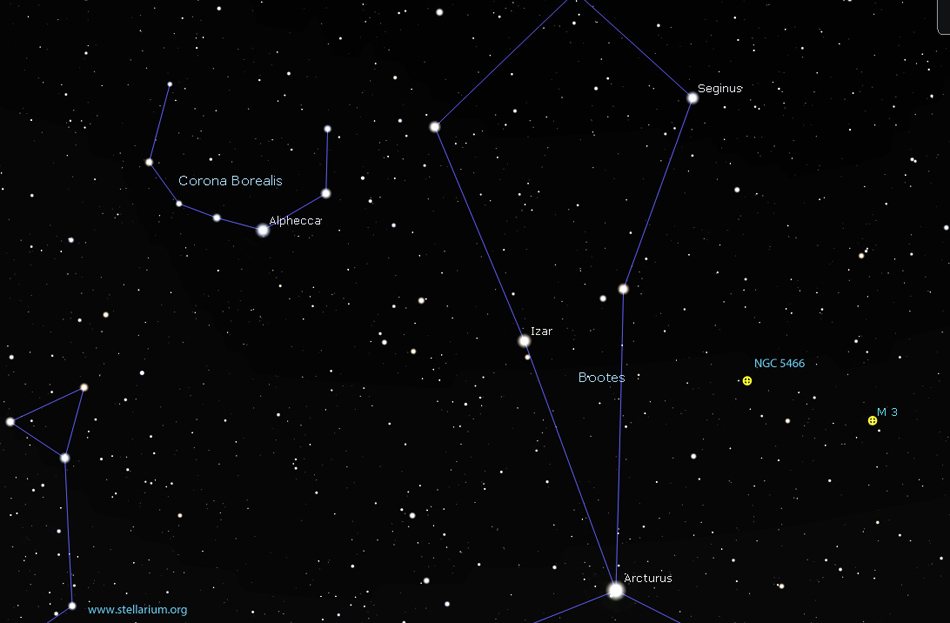Bootes
My favourite time of night before locating celestial treasures with the telescope or take long exposures of star fields with the camera is dusk. Within a few minutes after sunset, the brightest stars begin to reveal themselves one by one at a time like popcorn, first the brightest then fainter and fainter add to the mix. On these warm June nights, the first star to break the dark blue sky is Arcturus located overhead. At magnitude -0.11, it is listed as the fourth brightest star in the entire sky behind Sirius, Canopus and Rigel Kentaurus with Vega a close fifth. Arcturus is designated as the Alpha star in the constellation Bootes the Herdsman and is a K2 sun located 35 light-years from earth. It has proper motion and moving through space at 118 km/s.
The constellation Bootes is home to numerous fainter galaxies but an easier target is the highly resolved globular cluster named M3. You will spot it about 12 degrees to the west of Arcturus over in the constellation Canes Venatici. This cluster is located 33,900 light-years from us and measures about half the size of the moon with an estimated population of half a million stars. Even at this amazing distance, it still has a brightness of magnitude 6.2. For a challenge object, try locating NGC 5466 at 52,000 light-years away. This magnitude 9.0 dim patch is dubbed the “Ghost Globular Cluster". From Arcturus, slew your scope nine degrees to the north and a bit to the west.

For the past six months, the planet Venus has been our western companion, but it is now time to say goodbye. It will be in inferior conjunction between the earth and sun on June 3 and not seen. It does however return to the early morning sky by the end of the month. As for the other naked-eye planets, tiny Mercury will be at its highest point in the western sky on June 4 at 24 degrees from the sun. Over the next three weeks, it rapidly sinks towards the western horizon to become a morning object in July. On the early morning of June 13 around 3 a.m., Mars will be located one a half degree south of the planet Neptune. Although Mars is gaining in brightness, you will require a telescope to see Neptune at magnitude 7.89.
We had hoped to be good news in the comet viewing department as great expectations of viewing a bright Comet Atlas in the western sky, only to have it break apart and fade away before the big show. Then Comet Swan which gave fantastic views south of the border was not well placed to be seen and imaged from Canada. Now there is Comet C/2019 U6 (Lemmon) which comes close to the sun on June 18 but will hug the western horizon after sunset and not be a great attraction.
The June Bootids meteor shower occurs from June 22 to July 2 with a peak of only 1 or 2 per hour on the night of June 27. However, this display has been known to erupt in past years into a good shower. Time will tell on this one. There are two eclipses in June which are not visible from North America. First is the penumbral eclipse of the Full Strawberry Moon on June 5 and will be seen in Asia, Europe and Africa. It will not be much of a show as the moon catches the outer portion of the earth’s shadow and slightly darkens. Then on June 21 and the day after Summer Solstice which will occur on the 20th at 4:44 p.m. eastern, the new moon will pass in front of the sun and produce an annular eclipse. With the moon being at a far point in its elliptical orbit around the earth, it will not cover the entire sun producing the 1% ring around the sun like a wedding band. Unfortunately, this event will take place over the same areas as the lunar eclipse and far from North America.
Until next month, clear skies everyone.
